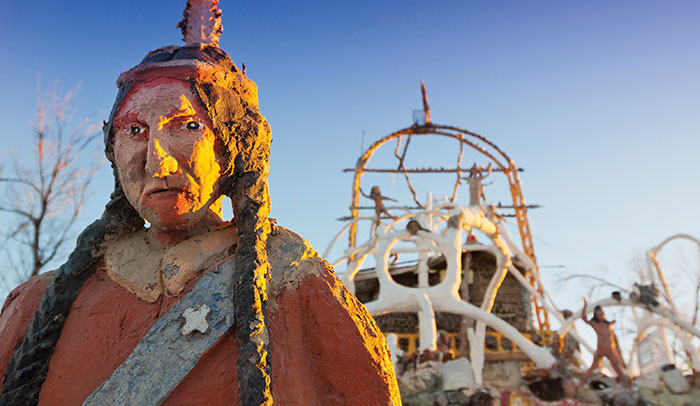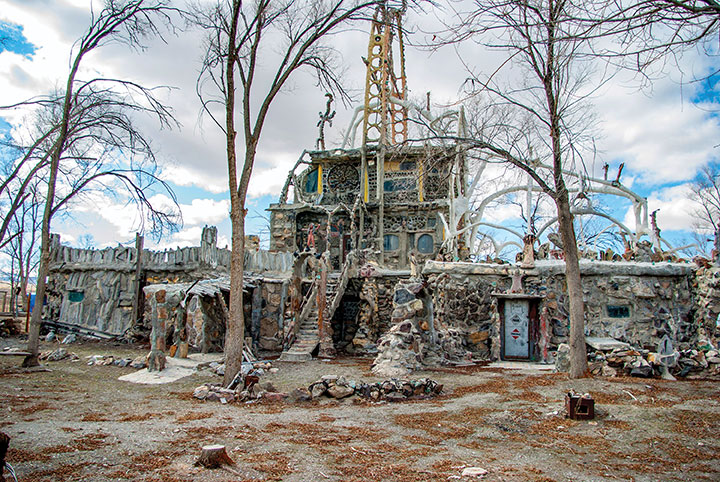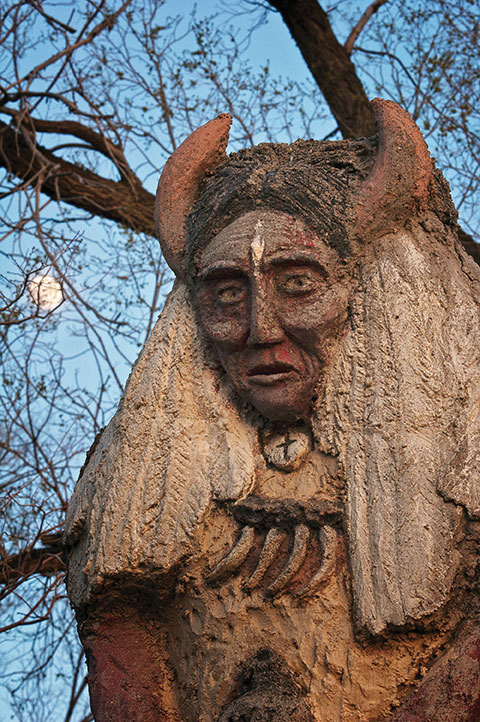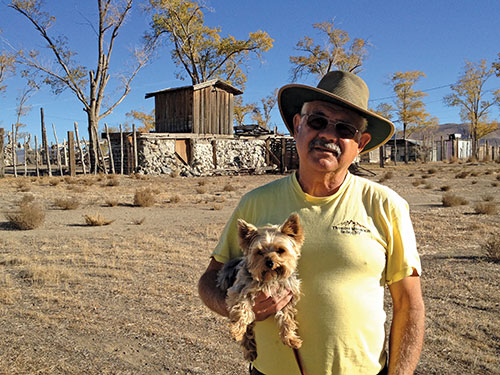Thunder Mountain
March – April 2013

Mysterious Imlay monument beckons Interstate 80 travelers.
(This story first appeared in our March/April 2013 issue)
BY GREG MCFARLANE
If you’ve ever traveled east from Reno, Fernley, or Lovelock to Winnemucca, you’ve driven by it. You might not have thought twice to look, and if you didn’t, you could easily have missed it even though it abuts Interstate 80.
“It” is Thunder Mountain Monument, nominally a monument but also an enigmatic roadside curiosity, a colossal sculpture (or series of sculptures), a living quarters, a rock garden, an otherworldly place of silence and mystery, and the life’s work of one exceedingly unusual Nevadan.
The Man Behind THUNDER Mountain
Thunder Mountain was conceived and created by Frank Van Zant, who was an archetype for the kind of independent thinker who’s drawn to our wide-open state. Van Zant was a World War II Army veteran, deputy sheriff, Methodist minister-in-training, indefatigable collector, and something of a visionary.

Van Zant lived in Northern California throughout the 1960s, where he worked for the United States Forest Service as an archaeologist. One day, the agency took him up on the deal of a lifetime—in exchange for plat maps that he created, Van Zant got to keep any artifacts he found. The only condition was that he had to disclose where he’d located them.
Laden with years of the treasure that was other people’s trash, and having recently lost his bid to be a county sheriff, Van Zant headed east in 1968. He stopped on the outskirts of Imlay, today a living ghost town of barely 100 people and back then only slightly more populated. In later years, Van Zant might credit the finding of his new home to serendipity or supernatural forces, but the real story is less fanciful: Imlay was where his truck broke down.
Inspired by his new surroundings, Van Zant adopted a new heritage and dismissed his Dutch name in favor of a Creek Indian one: Rolling Mountain Thunder. His motivation for building the monument was pure, if eclectic: Van Zant wanted to commemorate the original inhabitants of the area. Alternately, he said he wanted to recreate a curious structure he had seen in Death Valley, only on a much greater scale.
In addition to these explanations, Van Zant would regularly invoke the name of the Great Spirit and insist this was not merely his destination, but his destiny. Once Thunder Mountain was established, Van Zant would claim that he couldn’t leave even if he’d wanted to. Every time he had plans of driving too far away, his truck would break down and he’d be forced to return.
Building Thunder Mountain
Thunder Mountain is the culmination of a conception unswayed by such workaday concerns as blueprints and design plans. The building “sketches” existed nowhere but in Van Zant’s mind. He’d often get up in the middle of the night, inspired by a vision (what most people would call a “dream”), and commence painting and hammering.

Bit by bit, Thunder Mountain came together, conditional on the resources available and the labor at hand. Drawing on the legend of the Plains Indians using every available part of a bison, leaving little waste, Van Zant created Thunder Mountain largely from others’ trash. If it was transportable, nonporous, and within 50 miles of Imlay, Van Zant would find a way to incorporate it into one of the structures on the property.
Where a less resourceful person might see an irretrievably broken typewriter, Van Zant saw a design element for a banister. A single discarded bottle might not be interesting on its own, but several dozen arranged in a circle formed the bulk of a makeshift stained glass window.
“Makeshift” is a word you can use to describe several aspects of the creation of Thunder Mountain, including its workforce. While transforming the property from untrammeled desert scrub, Van Zant would take donations of volunteer toil in exchange for food and a place to stay. Some stayed for a day, some for a week, and two hippies made Thunder Mountain their home for six years. Unfortunately, what the help possessed in enthusiasm, it often lacked in expertise and craftsmanship. Van Zant would have to rebuild entire walls and sections that wouldn’t have withstood gravity, let alone building codes.
Life (and Death) at Thunder Mountain
For years, Thunder Mountain was more than a monument. Among other things, it was a domicile—Van Zant lived in the main building at the center of the property, along with at least a few members of his ever-expanding clan. Van Zant married multiple times and had eight children upon meeting his final wife. The central structure in which the family lived was, and remains, a labyrinth of false doors and walls fashioned from the hoods of cars.
One anecdote illustrates the story of Thunder Mountain and its founder better than any other. Van Zant had named one daughter after a type of igneous rock, raising her in a cramped upper-floor bedroom that in its current state looks like it had been borrowed from one of Lewis Carroll’s most detailed nightmares.
As the narrative goes, during the winter Obsidian Van Zant turned 13, her father handed her a rifle. He told her to head up to nearby Sacred Canyon, use the survival skills he’d taught her, and see if she could make it through the winter.
Months later she returned in perfect condition, a testament to her resourcefulness, only to draw the attention of Pershing County School District representatives who wondered who this girl was and why she had never seen a classroom. Forced to enroll, Obsidian, her mother, and the rest of the children eventually left Thunder Mountain and Van Zant.
Divorced, alone, and not in the greatest of health, 67-year-old Van Zant laid down in the center of his monument and took his own life in 1989. With no one to take care of it, Thunder Mountain was in danger of dying a more drawn-out death of its own. Until a savior came.
Thunder Mountain Today

Some parents will their children an attic full of knickknacks amassed over the decades, leaving its cataloging up to the heirs. Dan Van Zant, Frank’s oldest son, inherited five acres of statuary, found objects and unclassifiable arts and crafts projects. A retired supermarket executive, the younger Van Zant lives a considerably more conventional life than his father did, with wife and family a few miles outside of Redding, California.
Dan poured money and concrete into Thunder Mountain, steadfastly keeping it from falling into irreparability. He still checks up on the place once a month or so. At one point, Dan attempted to donate the property to the Nevada Division of State Parks. Without enough money to devote to the necessary repairs and preservation, the state politely declined. Instead, Thunder Mountain must rely on donations from passersby.
From November through March, the monument averages up to five vehicles a day. There’s a donation box, which grosses $100 to $200 a month. The rest of the year, traffic and contributions pick up. A typical summer month can see 20 daily vehicles and $450 in proceeds. That might not sound like enough to keep the place protected and maintained, yet Thunder Mountain manages. Besides, you never know where good fortune will come from. One benefactor of a few years ago toured the grounds, got in his car, and proceeded to mail a check for $20,000.
Dan leaves day-to-day operations of Thunder Mountain in the hands of on-site curator Fred Lewis. A one-man historical resource unto himself, Lewis is a childhood friend of Dan’s. The two got reacquainted by chance years later, and Lewis took his current position in 2011. Lewis and his intrepid puppy companion Oscar patrol the Thunder Mountain grounds from a decked-out trailer equipped with modern conveniences. Visit at the right time, and you’ll find Lewis walking the premises, happy to take a moment to share the unbelievable story of Thunder Mountain.
Lewis keeps a workshop in the roundhouse, which serves as the property’s central office and data center. It boasts an automated machine tool Lewis uses to create stellar individual woodwork pieces, available for admiration if not sale. There are also silkscreened souvenir T-shirts visitors can buy.
To quote the famous epitaph of Christopher Wren, inscribed upon his signature work, St. Paul’s Cathedral: “If you seek his monument, look around you.” The same applies to Frank Van Zant’s lasting contribution to Nevada’s vivid tapestry, which continues to fascinate and capture the imagination of those who happen upon it.
TAKE A LOOK
Thunder Mountain Monument
Interstate 80, Exit 145 at Imlay
thundermountainmonument.com

